YUGOSLAV MODERNISM, MONUMENTALITY, AND MEMORY: A CONVERSATION
I used to follow a lot of pages about socialist monuments and architecture. There are several initiatives campaigning for the preservation of modernist, socialist-themed monuments inside and outside the territories of the ex-socialist countries. Most of them are endless lists of photographs aiming mostly at a straightforward mapping of the socialist monumental heritage. Nevertheless, it was obvious—at least to me—that Yugoslav monuments differed from other projects of socialist monumentalising. They had an explicit and unique aesthetic value that seemed at times to transcend but also maintain a consistent historical dialogue with their complex historical contexts and narratives. Yugoslav post-World War II monumentalism appeals to something more than the typical socialist nostalgia. Consequently, I started following more closely initiatives about ex-Yugoslav monuments. Thus, I stumbled upon the page “Spomenik_a_week,” a project that, as the name indicates (spomenik translates to “memorial” in Serbo-Croatian), was dedicated to posting a different Yugoslav monument every week. A close friend was also familiar with the project and its creators, describing them as people who possess a deep love and curiosity for socialist monuments, particularly those from Yugoslavia.
Therefore, we had a brief discussion with the founders of project Spomenik_a_week, who are known as Boris and Anđela. The purpose of our discussion was not strictly an analysis of socialist monuments, the remembrance or obliviousness of socialism today. It would—as it turned out—be inadequate to analyze these monuments only in the context of socialism and its memory. While these are undoubtedly monuments constructed by a country—either the government or civic groups—that was socialist in the specific Yugoslav context, the interest revolved more around the complex narratives that are anchored and triggered by the monuments today and how people relate to and behave towards the monuments. The monument is a memory of the past, a memory of events; it is also a continuous point of reference and a presence as a symbol and material object in the life of communities. It is also a functional object that can be used in parallel or stripped of its symbolic claims. A monument is not the same, materially and symbolically, at the time of its erection and the present” or more simple “a monument changes, materially and symbolically, from its creation to the present. Even more, it is the monument’s materiality that captures the wear and aging but also the persistence of the successive, often contradictory levels of experience that are inscribed on it. It is a palimpsest of social contradictions but also a promise for the future, that memory is a continuous practice, not necessarily attached to the past but rather to the continuity of time. Of course this can be said about all architecture, but specific pieces seem to have an extensive, qualitative surplus of the ability to symbolize experiences. Especially in the Yugoslav context, the special, unique adventure of Yugoslav socialism but also the experience of the recent war and dissolution are integral parts of the symbolic language and the symbolic interpretation of these monuments. But there is much more, as we will see. As history progresses, it invests these places with new social practices. A monument (Spomenik) is therefore something beyond a melancholic echo. As they themselves say, Spomenik is never one thing: “Spomenik is a monument, Sculpture, Memorial of Revolution, Tombstone, Unwanted heritage, Scarecrow, Target, Selfie spot, Picnic area, and?” –
Dimistris M. Moschos
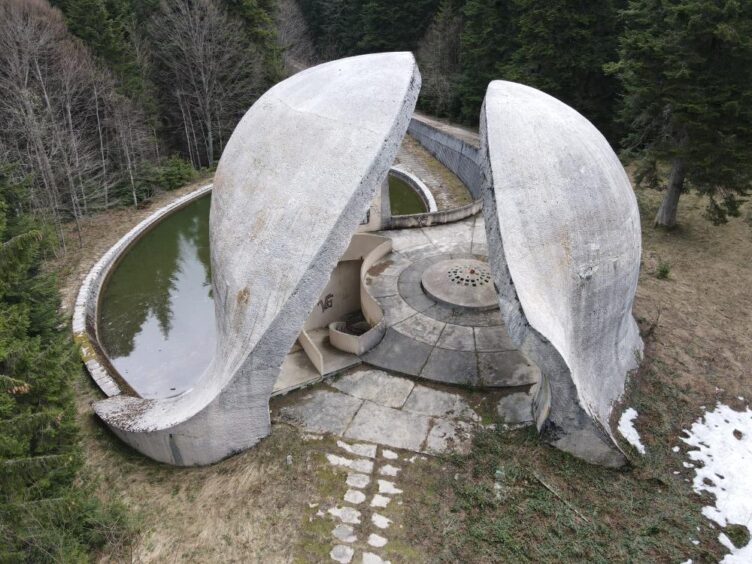
Grmeč, Bosnia & Herzegovina *one Instagram follower said: If architecture has a version of poetry, this is it!
Dimitris M. Moschos. So, could you present yourselves? Who are you, what is your background, what do you do outside of this project?
Boris (Spomenik_a_week). I am an interdisciplinary artist, born in Zadar, Croatia, in the time when it was part of Yugoslavia. However, I left Zadar early, to pursue my studies and career in art and since then I lived in Bosnia and Herzegovina, UK, Germany, Italy. Currently I am based in Munich. Last ten years I’ve been working on a project that interconnects arts, architecture, heritage and many more. Practically, I’ve restored a group of stone houses in a historic little town in Dalmatia, Croatia.
Anđela (Spomenik_a_week). I am a cultural manager, currently working at the Faculty of Applied Arts in Belgrade, as the International Relations Coordinator. I was born in Kosovo but have been living in Serbia since ‘99.
DMM. So how did you come up with the idea and the desire to do the “Spomenik_a_week” project? What is the role of this project in your life and in general?
S. Coming from different locations, educational backgrounds, and generations, both of us had varied experiences and relationships with Spomeniks. Yet, at a certain point, we shared a common fascination and obsession with these monuments and their current condition, which led us to visit dozens of them during a single trip in 2022. The project emerged from this 10-day journey, allowing us to see the monuments across all the countries that once made up Yugoslavia. The goal was not just to visit as many monuments as possible in a short time, but also to capture and document them from above. This perspective had rarely been explored and offered something fresh. We felt an urge to share the photo and video material we had collected, while also continuing our dialogue about the monuments. Instagram, being a simple and accessible platform, provided a perfect space for this.
The decision to create the “_a_week” project stemmed from our desire to stay focused on the monuments and ensure that we worked together on it, even when other aspects of daily life demanded our attention. Of course, there were also the stunning visuals, too good not to share with others. Although there are many Instagram accounts related to Spomeniks, we believe our visuals offer a unique perspective and are worth adding to the conversation about these monuments.
DMM. How much time does this project take you in general? Take us through the process, how do you locate the monuments, how do you film them. Do you have a wider crew to collaborate and support you or is it just the two of you?
S. It’s hard to say, mainly because this project comes with the excitement of traveling to new places. Of course, traveling to these locations can take a lot of time. These sites are not always along the main routes, so one wouldn’t necessarily come across them. But, as mentioned, the thrill of the journey helps lessen the feeling that it’s taking too long. Post-production is also time-consuming, but since we post one Spomenik per week, regardless of other commitments, there’s always enough time to manage it. Ultimately, the planning and research take up the most time. We use multiple sources and various methods to locate the monuments. Sometimes, we rely on popular websites where people have already mapped many Spomeniks. Other times, we research by authors — for example, finding a new monument in a monograph of a particular artist and then tracking it down. Occasionally, we come across a monument that no one knows about, which is both exciting and frustrating. It can be extremely difficult to find information on these, and that takes a lot of time. For now, the project involves just the two of us, with no external collaborators.
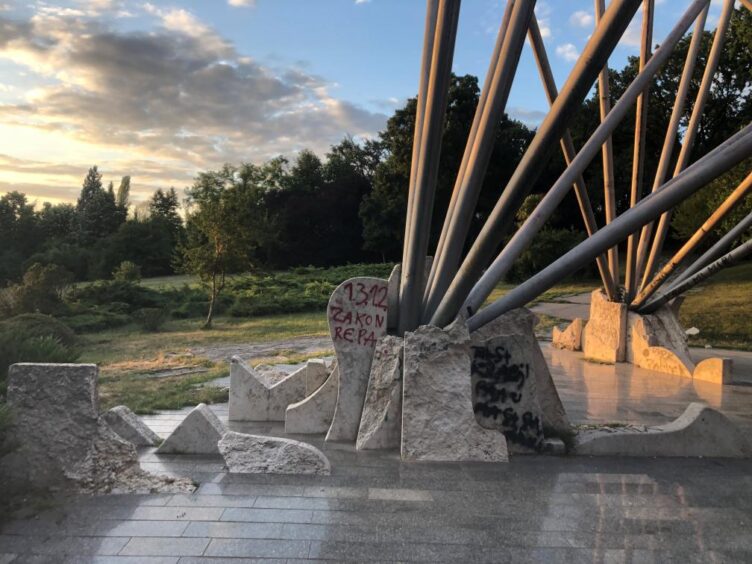
Čačalica, Serbia *the least convenient monument for graffiti, however, they found their way…
DMM. Speaking of location and selection of monuments, have you also (re)discovered some that you did not know about? Does the “spomenik_a_week” function also as a mapping project?
S. Yes, it’s also a mapping and research project. In addition to the Instagram page, we maintain our database that contains all the available data, along with other relevant information we find useful. We continue to discover new monuments and uncover new details, though it’s not always an easy task. One might assume that data, such as the year a monument was completed or the name of its author, would be easy to find, but in reality, it’s not. Sometimes, it requires reaching out to local museums, curators, or history teachers, which adds both an element of fun and an extra layer of significance to our work.
DMM. What do you think is special about Yugoslav socialist monuments? How would you describe them aesthetically, architecturally, historically, what do we know about them?
S. The unique thing about these monuments is, first and foremost, that they were built by a country that no longer exists. This creates a clear temporal cutoff. It’s interesting how we are often unaware of the sheer number of monuments dedicated to the anti-fascist struggle across the territories of former Yugoslavia. The majority of these were aesthetically unremarkable, consisting of simple plaques, signage, basic obelisks, or blocks of concrete or stone with minimal inscriptions, along with realistic sculptural portraits of historical figures or aestheticized representations of the same. The monuments we focus on make up a small percentage of these and stand apart in terms of size, artistic quality, and complexity. These particular monuments are distinguished by their unique combination of abstraction, modernism, and socialist ideals, marking a distinct departure from both the classical European monument tradition and the realism of Soviet art. The Yugoslav approach to monumental art was part of a broader European effort to create new, post-war national identities through visual culture. This style also absorbed the growing European Brutalist tendencies of the 1950s and 1960s. Brutalism, with its raw, unpolished concrete surfaces and monumental forms, was seen as a way of embracing modernity while rejecting the ornamentation of the past.
DMM. Ok, so a big question now. As far as I can say, Yugoslav monuments are distinctive in their abstractness from other socialist monumental traditions. For example, in Bulgaria you have Soviet style monuments (cosmos themed mosaics, mosaics on the socialist way of life), some memorial columns with inscriptions, and some patriotic monuments, especially in the Black Sea coast that have a very explicit expressiveness of content: they clearly state what they are about, what ideas tend to communicate. They were monuments of a political imperative, monuments of past memory or (as it was recently suggested in literature) monuments of posterity. The very etymology of the word spomenik suggests a relation to memory. On the other hand, in Yugoslavia we find a total abstraction of form, no clear political message propagation, sometimes no inscriptions etc. The Soviet and Bulgarian variant of monumentality is well researched, but I don’t think that this has been done respectively for the Yugoslav monuments. What are the reasons behind the aesthetical form of the Yugoslav monument? What is their cultural, political or even philosophical background? Does this have to do with Yugoslavia’s specific political adventure in the in-between of the two geopolitical forces of the 20th century?
S. Indeed, Spomenik in Serbo-Croatian (a language that no longer exists under that name, most similar to what is now referred to as BHS—Bosnian, Croatian, Serbian languages) translates to “memorial” and refers to any kind of monument or memorial. The term Spomenik(s) was actually attributed by foreigners, while in our languages, it is necessary to use phrases like “Monuments of Revolution,” “People’s Liberation Struggle Monuments,” or “WWII Monuments,” etc. The erection of these monuments was undoubtedly linked to the political situation in Yugoslavia after WWII: the creation of a “new nation” that included nations that had previously fought against each other. In this context, remembering the victims of fascism, one of the main purposes of the monuments, helped maintain unity against a common enemy. This is why many of the monuments were the result of public competitions, and it was clearly a pillar of the cultural policy in the newly formed country. The detachment from the typical socialist style is also reflected in a political shift away from the Soviet Union in 1948, following a non-aligned position that placed Yugoslavia outside the Iron Curtain. To translate this socio-political notion into aesthetics or a more formal definition of its expression, we could say that these monuments are defined by modernism and monumentalism. Generally speaking, these two aspects were not contradictory, but one was dominant in Western Europe, while the other prevailed in Eastern Europe.
The post-war period in Europe saw a strong shift towards modernism, as artists and architects embraced abstraction, experimentation, and new materials. Yugoslav monuments reflect this modernist influence to a certain degree, with many designed in dynamic forms that break from traditional classical styles. Modernism, with its emphasis on geometric abstraction and rejection of classical representational art, had a significant impact on the design of these monuments. At the same time, they incorporated monumentalism, a style focused on large-scale, visually striking works. This approach to scale was particularly suited to the post-war need for physical reminders of collective identity and strength. The desire to project power, unity, and resilience through monumental art was shared by other European countries at the time, particularly those under communist or socialist regimes. Somehow, Yugoslav monuments succeeded in creating a niche, or a subcategory, that blends both modernism and monumentalism into a singular expression.
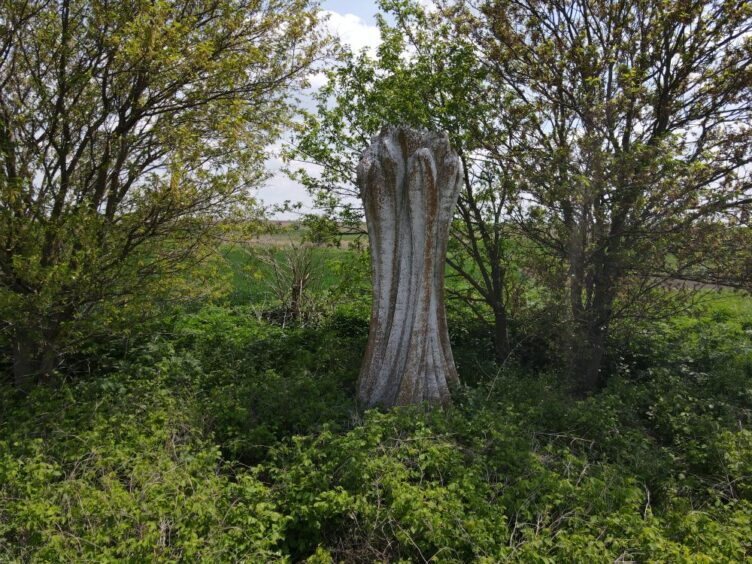
Surduk, Serbia *this one is completely hidden behind trees and bushes, surrounded by agricultural land. Once you realize the monument itself represents a sheaf of wheat, the surroundings are perfectly
suitable! We’ll never forget it—our car got completely covered in mud while driving through the
fields.
DMM. Monumentality is sometimes related with utopianism. Some of the socialist regimes, even though they were hostile to the term (Yugoslavia was far less though) were clearly utopian also, in terms that they elaborated projective narratives of a better, brighter future of their peoples, narratives that played significant role in their internal political libidinal economies and public image. On the other hand, abstraction of form such as of the Yugoslav monuments is utopian in a more narrow, futuristic way, evoking a feeling of awe and inspiration of collective dreaming. The monument also is an open space, a spatiality that can be appropriated for playful activities (as you also suggest in the description, spomenik is a place for picnic, selfies etc). Do we have here a case of aesthetic or functional utopianism in the socialist or post-socialist context?
S. It would be an overstatement to characterize it as utopianism. The dominant narrative of anti-fascism has evolved over time, incorporating additional elements that allow it to be understood as an ideology. Nevertheless, given its roots in the liberation struggle, there was a conscious effort to anchor monuments to that historical foundation, thereby avoiding a shift toward functional utopianism. The underlying aim of the ideology was not to idealize society or to change its direction, but rather to guide and sustain its development along a particular, existing trajectory.
As for their abstract forms and futuristic appearance, a short digression, they certainly present a foreigner’s perspective. If you look closer, the majority of these monuments symbolically depict simple objects such as a flower, a star, a flame, or a worker’s tool—magnificently represented in sculpture. We tend to romanticize these representations, but the reality is that these were places where mass murders took place, where the largest battles were fought, where partisan brigades were formed, or where other crucial events occurred. Considering how much the people fought against the fascists and how many lives were lost, what is truly fascinating is that the survivors—who were very poor in the post-war aftermath—were willing to fundraise and donate to build these monuments. So, rather than just collective dreaming, it was collective action. Of course, it was a priority for state policy, but it’s still remarkable that, in some cases, it was local communities that issued open calls, selected the best proposals, and donated funds for the construction.
DMM. What do you think was their intended function at their time by their designers and what was their interpretation by everyday people? Do we have such info at all?
S. Sure, we do, but not for all of them, and it’s not uniformed. After all, we’re talking about a period of over 30 years during which these monuments were constructed. Some of them were intended as political performances—sometimes provocative, sometimes educational, but most often celebratory. Although the monuments were often built on mass graves or in locations where people were murdered, the overall intention was to celebrate life as the highest tribute to the victims. Today, we have debates about whether it’s appropriate to hold concerts or take selfies at these monument locations. However, we must not forget that the Spomeniks were originally built as places of gathering, where regular commemoration events and organized visits took place. Some of these sculptures were erected in villages where Partisans had committed atrocities, but the official narrative has since turned the story around. In one such village, throughout the years of Yugoslavia, there was significant local resentment toward the particular monument. As soon as there was a political shift and, evidently, the material capacity (access to explosives), the sculpture was destroyed. We deliberately say the sculpture was destroyed, but not the monument. Obviously, the monument remains.
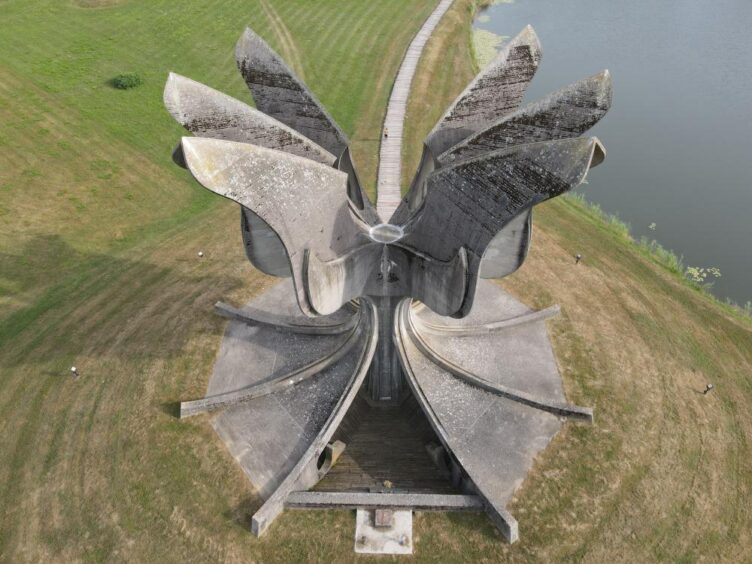
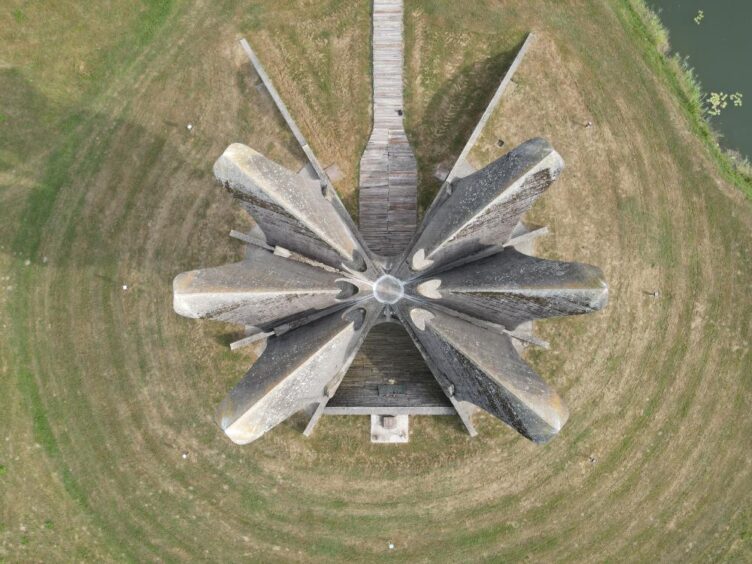
Jasenovac, Croatia *If the Gmeč monument is poetry, this one is magic. The entire complex is very well maintained, still we see it endangered because it serves as a strong symbol for serbian nationalism.
DMM. How are these monuments perceived now in the post-Yugoslav and Post-socialist era? In other cases, there is a huge controversy over socialist heritage monuments, but in these cases these monuments are also clearly expressive in their content. What is the situation now with these monuments in the various post-Yugoslav countries?
S. Our initial trip was particularly informative, especially in this aspect, because we visited so many monuments in such a short period of time. The differences in their conditions across different countries were more than obvious. We can say that the condition of the Spomeniks reflects the official policy and public opinion towards the country’s Yugoslav past. Once Yugoslavia dissolved, each of the newly formed countries had to reinvent their identity, often positioning themselves in relation to Yugoslavia. Given how violent the separation was, Yugoslavia became a negative and unwanted past (though not for everyone, and as time passes, we see more and more yugonostalgia). Furthermore, there was a superficial equation made between Yugoslavia and Communism, Communism and Anti-Fascism, and the Spomeniks, as symbols of this unwanted past, suffered greatly. Some of them were deliberately destroyed during the wars of the 1990s, while others were simply neglected and deteriorated due to time and exposure to the elements. As some of these monuments lost their function as commemoration sites, they became desolate places, providing convenient shelter for young people who used them as canvases for graffiti. We also have cases where memorial complexes were appropriated, with new sculptures added to commemorate victims of the most recent war. Some of these monuments were made of valuable materials like steel or copper, which led to parts being stripped down for profit. There are so many ways and reasons for the destruction of a monument.
Of course, some monuments are well-maintained, as they are still visited and require upkeep. Slovenia offers a good example of how to care for this heritage, with official policies that celebrate the anti-fascist past and put those policies into practice by maintaining the monuments.
DMM. Are some of these monuments perceived as “aesthetic ruins”, as “ruin porn”, a very popular artistic genre nowadays or not? What do you think is still appealing on them, because they clearly are, if we judge by the popularity of similar pages on social media that are posting them, (even though they don’t do it in the organized and consistent manner that you do). We know that they are popular also if we take into account that a whole sci-fi movie was shot only with scenes of Yugoslav monuments and a voice-over (voice-over by Tilda Swinton and directed by Jóhann Jóhannsson, Last and First Men, 2020).
S. The fascination with these objects is understandable. They required a great deal of effort and funding to construct, and now they lie in ruins, abandoned. Their appeal is perhaps even more unique because of their contemporary shapes, as they belong to a very recent history. They aren’t that old, despite how abandoned they appear. This may be what places them in a special category. These circumstances don’t necessarily have to be negative for the monuments today or for their future. However, there is a certain aesthetic that aligns with them, and perhaps others that don’t. We find it frustrating that a money-making series could be filmed at these sites, yet the sites themselves don’t profit from it. Especially when it’s so clear that the funds could be used to restore and preserve these monuments. Last and First Men by Jóhann Jóhannsson would probably be the most aesthetically and conceptually pleasing visual project to complement the initial aesthetics of these monuments. But, of course, this is just our personal opinion.
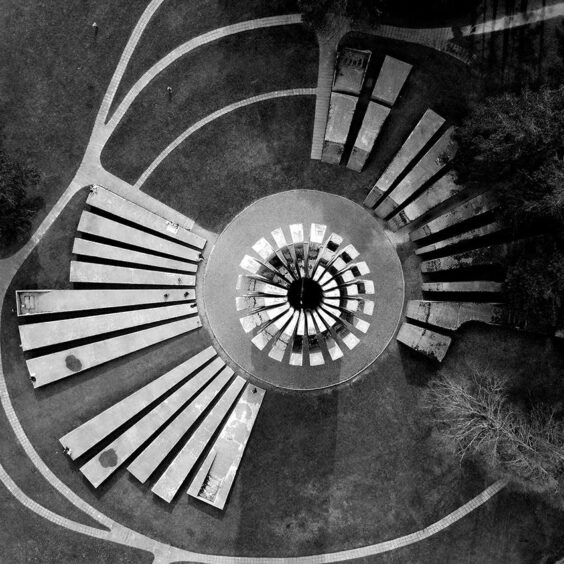
Kozara, Bosnia & Herzegovina *this is the format and style of every opening photo, a bird perspective of a Spomenik
DMM. Does “spomenik_a_week” play a function to raise awareness of the importance of these monuments nowadays? For example, in other countries, not only post-socialist, there are more or less well organized initiatives that are mapping modernist murals and monuments and are trying to raise awareness for their preservation, like in Britain the C20, or the “Ukrainian Mosaics” in Ukraine, initiatives that have raised awareness about the cultural value of modernism in tense political situations. Do you have something like that in mind or can in the future “spomenik_a_week” play such a role?
S. It definitely attempts to continue a dialogue about these monuments. It’s difficult to determine their precise importance. If there is a need to build something, that in itself implies importance. The same holds true for the need to destroy something. There is significant relevance in how these monuments mirror contemporary society’s struggle with accepting its identity. Perhaps their importance lies precisely in this aspect. However, if we view them as part of the history of art, they certainly deserve a more prominent place and recognition.
Our position is firmly in favor of their protection. We believe they should be conserved in their current condition. Obviously, those in hazardous conditions should first be stabilized, made safe, and then preserved in their ruined form. As monuments and time-signifiers, they continue their mission of retelling the past—perhaps even more truthfully in their current state than when they were first erected.
It seems to us that there are numerous small groups—sometimes professionals, sometimes amateurs, locals or foreigners—recognizing the importance of preserving these monuments, mostly by raising awareness, because any tangible work would be expensive. Thanks to Instagram, we’re connecting with other Spomenik enthusiasts, and that gives us hope that, someday, the situation may change. On the other hand, we are aware that public institutions responsible for monument preservation are failing in this task. There is no complete list of these monuments, no categorization, and they often lack the basic information we are searching for, such as the name of the author and the date of erection. There is still so much work to be done in the future.
DMM. What do these monuments mean for you, personally, and what do you think is the future of your project?
S. What’s most intriguing about them is the presence of multiple, often conflicting, narratives unfolding simultaneously. Many of these narratives oppose one another, and it still feels impossible to find a silver lining that runs through them all. It’s missing—just like the country that created them is missing. For us, they remain both a journey and a search—physically and internally.
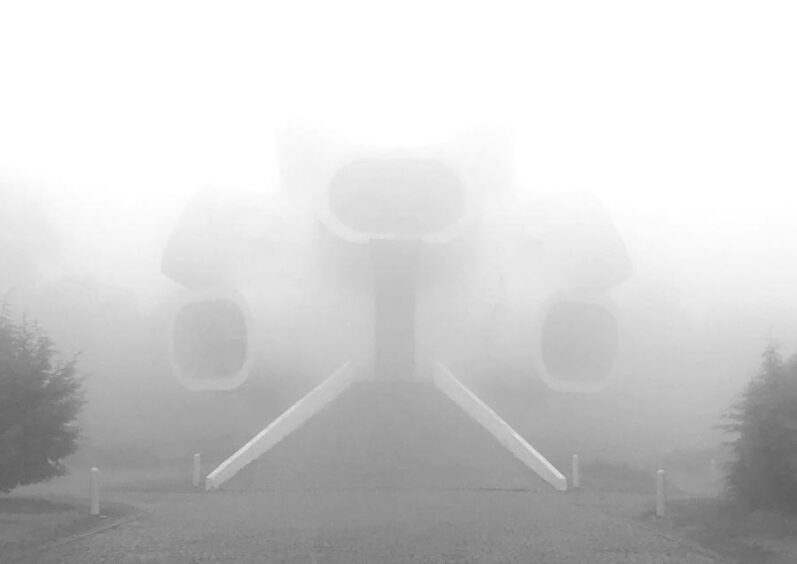
Kruševo, North Macedonia
X.
Dimitris M. Moschos is a Greek PhD researcher with a focus on the social policy of the urban space and the comparative study of state policies between different state regimes. His main research interest is the interrelationship between utopia, state policies, and urban planning. He focuses on the history of the New Towns Movement in Britain and Eastern Europe during the socialist period. He was born in Athens, Greece, in 1987. He studied history and archaeology, with a specialization in the history of Eastern Europe and political philosophy. He has translated in Greek works of literature, history, and political philosophy from Bulgarian, Russian, German, and English. He has published articles in academic and non-academic journals in Greece and abroad.
Anđela Jovanović holds an MA in Cultural Policy and Management (UNESCO Chair programme) and works as an Associate for International and Public Relations at the Faculty of Applied Arts in Belgrade. Her work bridges international education, heritage, and cultural policy, with a strong focus on critical and contested heritage. She advocates for heritage as community driven value, and a tool for pluralistic vision of the past and present.
Boris Kajmak is a Croatian interdisciplinary artist whose work explores the intersections of art, architecture, and cultural heritage. Trained in printmaking at the Academy of Fine Arts in Mostar and Central Saint Martins in London, he has exhibited internationally since 1999. Kajmak’s practice is rooted in material experimentation, conceptual design, and a deep engagement with language and social context. His work is informed by a commitment to preserving and reinterpreting intangible heritage—approaching traditional forms, techniques, and narratives not as relics, but as living, evolving elements of contemporary culture.